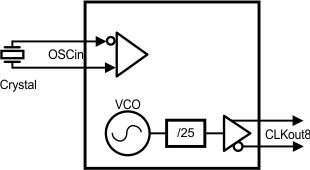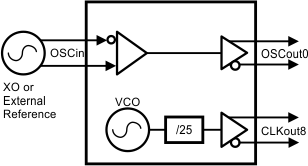SNAS522K September 2011 – December 2023 LMK03806
PRODUCTION DATA
- 1
- 1 Features
- 2 Applications
- 3 Description
- 4 Pin Configuration and Functions
- 5 Specifications
- 6 Parameter Measurement Information
-
7 Detailed Description
- 7.1 Overview
- 7.2 Functional Block Diagrams
- 7.3 Features Description
- 7.4 Device Functional Modes
- 7.5 Programming
-
8 Application and Implementation
- 8.1 Application Information
- 8.2 Typical Application
- 8.3 System Examples
- 8.4 Best Design Practices
- 8.5 Power Supply Recommendations
- 8.6 Layout
- 9 Device and Documentation Support
-
10Register Maps
- 10.1 Default Device Register Settings After Power On Reset
- 10.2 Register R0 TO R5
- 10.3 Registers R6 TO R8
- 10.4 REGISTER R9
- 10.5 REGISTER R10
- 10.6 REGISTER R11
- 10.7 REGISTER R12
- 10.8 REGISTER R13
- 10.9 REGISTER 14
- 10.10 REGISTER 16
- 10.11 REGISTER 24
- 10.12 REGISTER 26
- 10.13 REGISTER 28
- 10.14 REGISTER 29
- 10.15 REGISTER 30
- 10.16 REGISTER 31
- 11Revision History
- 12Mechanical, Packaging, and Orderable Information
Package Options
Mechanical Data (Package|Pins)
- NKD|64
Thermal pad, mechanical data (Package|Pins)
- NKD|64
Orderable Information
7.3.6 Default Start-Up Clocks
Before the LMK03806 is programmed some clocks will operate at default frequencies upon power up. The active output clocks depend upon the reference input type. If a crystal reference is used with OSCin, only CLKout8 will operate at a nominal VCO frequency /25. When an XO or other external reference is used as a reference with OSCin, OSCout0 will buffer the OSCin frequency in addition to CLKout8 operating at a nominal VCO frequency /25. These clocks can be used to clock external devices such as microcontrollers, FPGAs, CPLDs, and so forth, before the LMK03806 is programmed. Refer to Figure 7-5 or Figure 7-6 for illustration of start-up clocks.
The nominal VCO frequency of CLKout8 on power up will typically be 98 MHz.
Note during programming CLKout8 may momentarily stop or glitch during the VCO calibration routine.
 Figure 7-5 Start-Up Clock Using Crystal Reference
Figure 7-5 Start-Up Clock Using Crystal Reference Figure 7-6 Start-Up Clock Using XO or Other External Reference
Figure 7-6 Start-Up Clock Using XO or Other External Reference